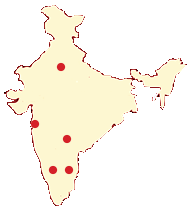Overview
Congenital heart defects usually are treated by a pediatric cardiologist and possibly a surgeon. Treatment for congenital heart defects, whether they are detected at birth or later in life, may involve medication, surgery, or a combination of both
There are many types of congenital heart defects. Most obstruct the flow of blood in the heart, or the vessels near it, or cause an abnormal flow of blood through the heart. Rarer types include newborns born with one ventricle, one side of the heart that is not completely formed, or the pulmonary artery and the aorta coming out of the same ventricle. Most congenital heart defects require surgery during infancy or childhood.
Recommended ages for surgery for the most common congenital heart defects are:
- atrial septal defects :- during the preschool years
- patent ductus arteriosus :- between ages one and two
- coarctation of the aorta :- in infancy, if it's symptomatic, at age four otherwise
- tetralogy of Fallot :- age varies, depending on the patient's signs and symptoms
- transposition of the great arteries :- often in the first weeks after birth, but before the patient is 12 months old
Causes :
Congenital heart disease (CHD) can describe a number of different problems affecting the heart. According to the American Heart Association, about 35,000 babies are born each year with some type of congenital heart defect. Congenital heart disease is responsible for more deaths in the first year of life than any other birth defects. Many of these defects need to be followed carefully. Some heal over time, others will require treatment.
While congenital heart disease is present at birth, the symptoms may not be immediately obvious. Defects such as coarctation of the aorta may not cause problems for many years. Other problems, such as a small ventricular septal defect (VSD), may never cause any problems, and some people with a VSD have normal physical activity and a normal life span.
Some congenital heart diseases can be treated with medication alone, while others require one or more surgeries. The risk of death from congenital heart disease surgery has dropped from about 30% in the 1970s to less than 5% in most cases today.
Congenital heart disease is often divided into two types:
The following lists cover the most common of the congenital heart diseases:
Cyanotic:
 Tetralogy of Fallot
Tetralogy of Fallot Transposition of the great vessels
Transposition of the great vessels Tricuspid atresia
Tricuspid atresia Total anomalous pulmonary venous return
Total anomalous pulmonary venous return Truncus arteriosus
Truncus arteriosus Hypoplastic left heart
Hypoplastic left heart Hypoplastic right heart
Hypoplastic right heart Some forms of total anomalous pulmonary venous return
Some forms of total anomalous pulmonary venous return Ebstein's anomaly
Ebstein's anomaly
Non-cyanotic:
 Ventricular septal defect (VSD)
Ventricular septal defect (VSD) Atrial septal defect (ASD)
Atrial septal defect (ASD) Patent ductus arteriosus (PDA)
Patent ductus arteriosus (PDA) Aortic stenosis
Aortic stenosis Pulmonic stenosis
Pulmonic stenosis Coarctation of the aorta
Coarctation of the aorta Atrioventricular canal (endocardial cushion defect)
Atrioventricular canal (endocardial cushion defect)
Neonatal Surgery for Heart Conditions :
One of our specialties is the repair of very complex neonatal heart conditions in premature (and low birth weight) babies. As a regional referral center, families from throughout the state come to California Pacific to receive care for a premature child or a fetus in which heart abnormalities are detected.
 We are also frequently asked to evaluate babies prior to birth when the fetus is recognized as having a heart defect. Common neonatal conditions corrected by our surgeon include ventricular septal defects (VSDs), Tetralogy of Fallot and total anomalous pulmonary venous abnormalities. These complex neonatal disease repairs are performed using minimally invasive surgery and often employ innovative brain protection strategies. Brain protection is critical to maintaining neurological function and learning potential. These capabilities may be compromised when blood flow to the brain is stopped—even briefly—during surgery.
We are also frequently asked to evaluate babies prior to birth when the fetus is recognized as having a heart defect. Common neonatal conditions corrected by our surgeon include ventricular septal defects (VSDs), Tetralogy of Fallot and total anomalous pulmonary venous abnormalities. These complex neonatal disease repairs are performed using minimally invasive surgery and often employ innovative brain protection strategies. Brain protection is critical to maintaining neurological function and learning potential. These capabilities may be compromised when blood flow to the brain is stopped—even briefly—during surgery.
Echo-Assisted Open Heart Surgery :
Echocardiography or ultrasonography of the heart is routinely performed during all open heart procedures, regardless of size. Once the child or adult is fully under anesthesia, a probe is placed within the esophagus allowing for excellent views of the intra-cardiac structures. Occasionally when a neonate is very small, weighs less than 2.5kg, or when there is a history of esophageal pathology, an epicardial study is perfomed by placing a small probe directly on the heart.
The advantage of such routine surveillance is the determination of subtle abnormalities and improved quality of the surgical repair. Rarely we can avoid an open heart procedure by using the echocardiographic pictures “real-time” allowing for procedures to be performed without incising the heart chambers but rather by placing precise instruments through small ports within the heart tissue.
Extracorporeal membrane oxygenation (ECMO)
ECMO is the use of an artificial lung (membrane) located outside the body (extracorporeal), that puts oxygen into the blood and then carries this blood to the body tissues (oxygenation). As the heart improves, the amount of blood flow through the extracorporeal membrane oxygenation circuit can be decreased, allowing the heart and lungs to do more of the work. California Pacific Medical Center was the site of the first successful ECMO case in 1977. Although rarely used, having ECMO readily available can permit heart muscle recovery in the most extreme cases of heart failure following complex open heart procedures or in cases of devastating lung failure.
Extracardiac Fontan :
Extracardiac Fontan is performed for children or adults with single ventricle physiology. The Fontan procedure connects the right atrium to the pulmonary artery, thus separating the systemic and pulmonary venous circulations.
Intraoperative Stenting :
In this procedure, the surgeon and interventional cardiologist work together to insert a stent (and open up a blockage), most often within the pulmonary artery. By using minimally invasive techniques to open the chest, the physicians can insert a larger stent that will last longer than one threaded through the groin vessels.
Pacemakers :
Sometimes, one’s heart rhythm needs to be electrically stimulated so it will maintain a normal heartbeat. In these cases, our cardiovascular surgeon may implant a pacemaker, which helps to restore one’s heart rhythm and improve its ability to circulate blood through the body.
Ross Procedure :
Some children and adults require an aortic valve replacement when other strategies have failed or are not indicated (i.e. balloon catheter dilation or valve repair). In these cases, a patient’s pulmonary valve is removed and used as the heart’s aortic valve and an artificial tissue valve is inserted in its place.
This procedure is more complex than just replacing the valve with an artificial one, but has the advantages of:
 No artificial valve noises
No artificial valve noises No need for anticoagulation or blood thinners
No need for anticoagulation or blood thinners Resistance to infection
Resistance to infection Potential for growth (an important consideration for neonates, children and young adults)
Potential for growth (an important consideration for neonates, children and young adults)
For more information, medical assessment and medical quote
as email attachment to
Email : - info@wecareindia.com
Contact Center Tel. (+91) 9029304141 (10 am. To 8 pm. IST)
(Only for international patients seeking treatment in India)










